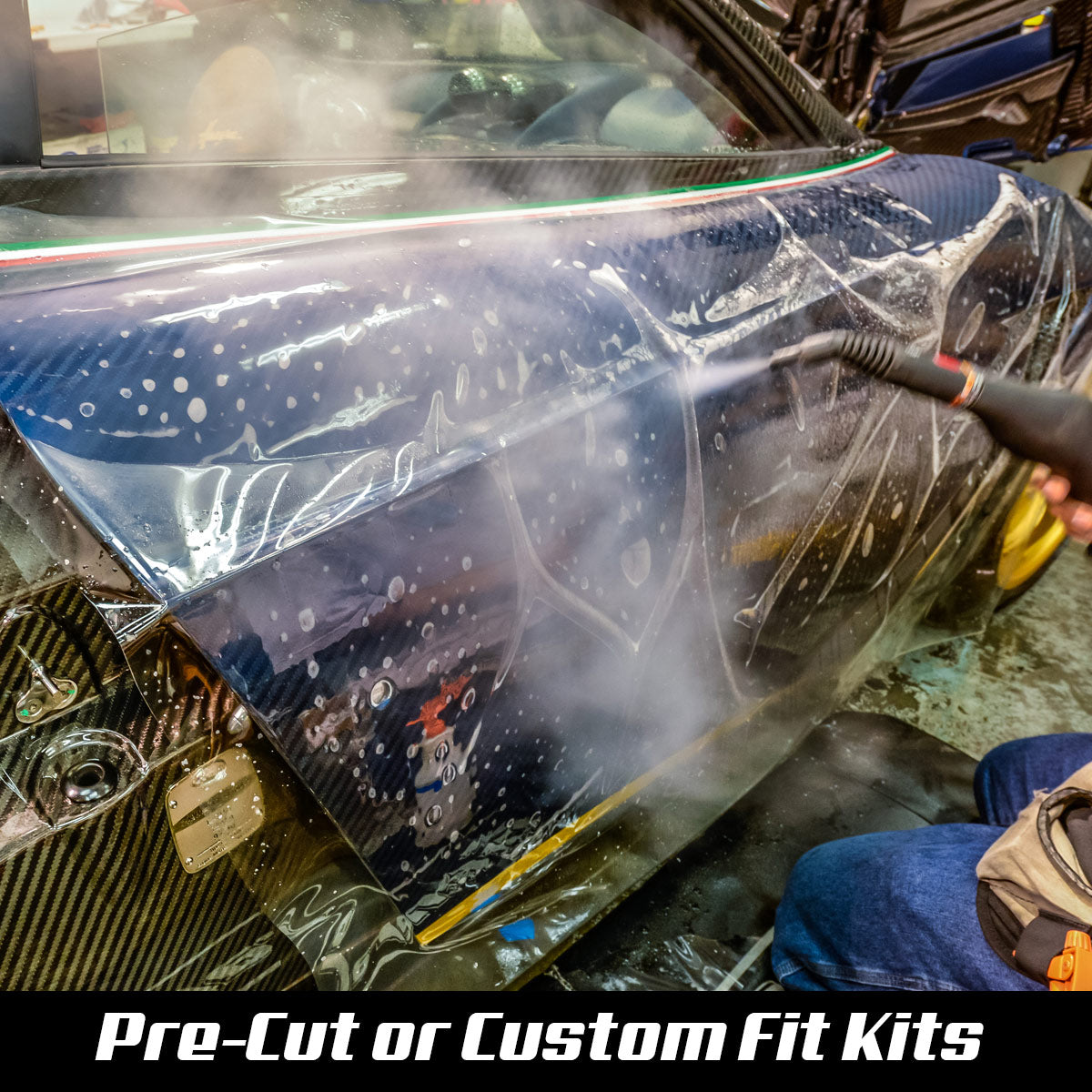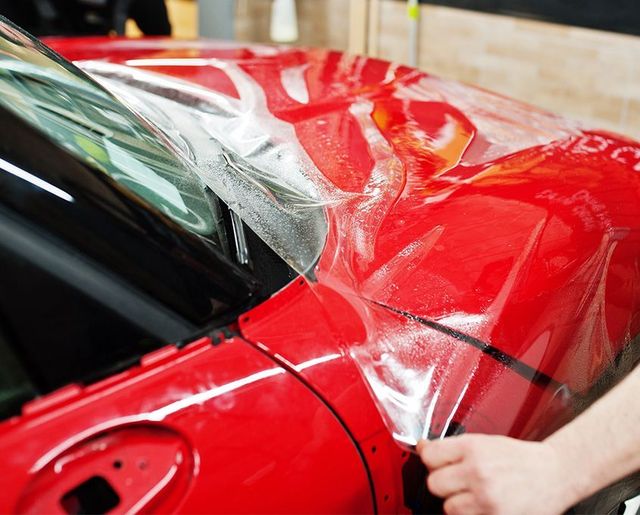The Ultimate Guide to Understanding Paint Protection Film for Auto Lovers
Paint Protection Film (PPF) has come to be a vital topic among car fanatics seeking to preserve their car's look. This advanced safety layer provides countless benefits, from protecting against environmental dangers to maintaining resale value. Recognizing the different sorts of PPF, the application procedure, and maintenance tips can significantly influence one's financial investment. Yet, many misunderstandings linger. What are the most typical misconceptions, and how do they compare to various other protective options?
What Is Paint Protection Film (PPF)?
Paint Protection Film (PPF) works as a clear shield for automobile surface areas. This innovative polyurethane material is developed to stick seamlessly to a car's outside, giving a protective layer against different ecological threats. PPF is often put on high-impact areas, such as hoods, bumpers, and mirrors, where scratches and chips are most likely to occur.The movie is extremely sturdy, using resistance against UV rays, road debris, and chemical stains, which can deteriorate a lorry's surface with time. Its self-healing homes permit small scratches to go away with heat direct exposure, maintaining an immaculate look. PPF is available in different coatings, consisting of gloss and matte, to match various paint styles and preferences.Installation needs precision, typically best done by experts to ensure a flawless application. In General, Paint Protection Film is an innovative service for vehicle enthusiasts seeking to maintain their lorry's aesthetic charm while securing its surface integrity.
Benefits of Utilizing Paint Protection Film
While lots of vehicle fanatics prioritize aesthetic appeals, the useful benefits of Paint Protection Film (PPF) are equally compelling. PPF acts as a durable barrier versus various ecological hazards, consisting of road debris, rock chips, and insect stains, successfully preserving the lorry's exterior. In addition, it offers UV security, preventing paint from fading and preserving the auto's lively shade over time.Another significant advantage is the self-healing homes of sophisticated PPFs, which can recover from minor scrapes and swirl marks with heat exposure, making sure the finish remains immaculate. Installment of PPF can also improve resale worth; possible buyers are typically brought in to well-maintained lorries with no noticeable blemishes. PPF is easy to tidy and calls for marginal upkeep, permitting car enthusiasts to enjoy their cars without the stress of continuous upkeep. In general, PPF integrates performance with appearances, making it a practical investment for cars and truck connoisseurs.
Various Kinds Of Paint Protection Film
Recognizing the numerous kinds of paint security film is essential for vehicle enthusiasts. Key features such as self-healing modern technology, contrasts of density and toughness, and application methods play an essential duty in picking the right choice. Each type offers distinctive benefits that satisfy various demands and preferences.
Self-Healing Technology Explained
Self-healing modern technology changes the method automobile enthusiasts protect their cars from scratches and small damages. This innovative function is primarily found in sophisticated paint protection movies (PPF) When exposed to heat from sunlight or a warm setting, the distinct polymers within these movies soften, allowing little scratches and swirl marks to "heal" themselves. This self-repairing capability not just preserves the film's aesthetic charm but likewise extends its safety high qualities. Numerous brand names provide various formulas of self-healing films, each with distinctive characteristics customized to specific requirements. Automobile enthusiasts value this modern technology for its ability to keep their cars looking immaculate, decreasing the frequency of fixings and guaranteeing a longer-lasting safety remedy against daily deterioration.

Density and Toughness Comparison
Thickness and longevity are essential elements when reviewing various kinds of paint defense film (PPF) PPF commonly ranges in thickness from 6 mils to 12 mils, with thicker movies using boosted resistance to scrapes, chips, and ecological damages. Thinner films, while much less protective, often provide better clarity and conformability, making them appropriate for detailed styles and contours. Durability varies among brands and kinds; some movies integrate innovative products that enhance their lifespan and preserve their appearance gradually. Furthermore, self-healing residential or commercial properties in specific PPF kinds can better expand longevity by allowing minor scratches to disappear with heat. Inevitably, the selection of density and resilience ought to line up with the particular requirements and preferences of the vehicle lover.
Application Methods Summary
Choosing the best application technique is important for optimizing the advantages of paint security movie (PPF) There are different methods available, each suited to various preferences and skill degrees. One of the most usual methods include the conventional wet application, which makes use of a slip remedy to assist in positioning, and the completely dry application, which calls for accuracy and experience for instant bond. Additionally, advanced alternatives like pre-cut packages provide benefit, developed to fit particular vehicle versions, while mass film enables personalization however demands extra proficiency (SpeedEFX Paint Protection Film). Each strategy provides distinct benefits and difficulties, making it important for auto lovers to choose one that straightens with their goals and capabilities, inevitably making sure perfect defense for their cars
The Application Refine of PPF
The application procedure of paint protection film (PPF) involves several crucial actions to ensure optimal outcomes. Extensive surface area preparation is necessary, complied with by specific setup strategies that make the most of bond and insurance coverage. Finally, appropriate post-application treatment is essential to preserve the movie's honesty and appearance in time.
Surface Area Prep Work Steps
Proper surface preparation is necessary for an effective paint defense film (PPF) application, as it straight influences the film's adhesion and durability. The initial action entails extensively cleaning the vehicle to remove dirt, gunk, and click here to read other pollutants. A pH-neutral auto soap is recommended to avoid damaging the paint. Following the clean, the surface area needs to be dried out meticulously with microfiber towels to stop water spots. Next, any existing imperfections, such as scrapes or swirls, need to be dealt with, typically using a gloss or substance. The surface area ought to be wiped down with an isopropyl alcohol solution to assure it is entirely tidy and totally free from oils or residues. This thorough prep work lays Visit Website the foundation for a successful PPF installment.
Installation Methods Discussed
Understanding the application procedure of paint security film (PPF) is essential for attaining the very best results. The installment commonly starts with precise dimensions of the automobile's surfaces to ensure appropriate coverage. Sanitation is vital; the surface has to be complimentary of dust, dust, and pollutants. An installer often makes use of a slip service, which helps with positioning the film throughout application.The movie is meticulously laid onto the surface, making use of tools like mops to get rid of air bubbles and excess option. Warmth may be put on adhere the movie to complex contours and contours. Correct positioning and tension are important for a smooth finish. Trimming excess movie assures a clean edge, finishing the installment process successfully and boosting the automobile's aesthetic appeals and defense.
Post-Application Care Tips

Maintenance Tips for Long-Lasting Protection
How can vehicle enthusiasts assure their paint security film stays efficient in time? Regular upkeep is necessary to protect the film's long life and performance (SpeedEFX Paint Protection Film). To start with, cleaning the automobile with a pH-balanced automobile shampoo aids avoid the buildup of impurities that might harm the movie. Using a microfiber towel for drying is recommended to stay clear of scratches.Additionally, it is crucial to avoid unpleasant cleaning devices or extreme chemicals, which can weaken the movie's surface area. Applying a sealer or wax particularly made for paint security movie can supply an additional layer of defense versus UV rays and environmental elements.Furthermore, lovers should regularly inspect the movie for any kind of indications of wear or damages, attending to issues immediately to keep its protective top qualities. Vehicle parking in shaded locations or using cars and truck covers can also decrease direct exposure to damaging UV rays. By complying with these maintenance suggestions, car lovers can assure their paint protection film remains effective for numerous years
Typical Misconceptions About Paint Protection Film
What false impressions surround paint protection film that car lovers should recognize? One prevalent myth is that paint security movie (PPF) makes a vehicle look unsightly or yellow with time. Actually, premium PPF is made to continue to be clear and keep its look. Another typical belief is that PPF is only needed for brand-new autos; nonetheless, any vehicle can take advantage of this safety layer, no matter of age. Some site lovers additionally assume that PPF is as well costly; while it might need an in advance investment, the long-lasting financial savings on paint fixings can counter preliminary expenses. Furthermore, numerous presume that PPF is a DIY project, yet specialist installment assurances proper placement and attachment, taking full advantage of efficiency. Lastly, there is a misunderstanding that PPF is not resilient, yet developments in technology have made modern-day movies resistant to scrapes, discolorations, and UV damage, supplying trustworthy security for years.
Contrasting PPF to Other Protection Options
Recognizing the different alternatives offered for car defense is essential for vehicle fanatics who desire to preserve their lorry's appearance. Paint Protection Film (PPF) is often compared to wax, ceramic coverings, and conventional sealers. While wax uses a short-term sparkle and basic defense, it generally needs regular reapplication and offers restricted durability. Ceramic finishes provide improved defense against UV rays and chemical spots, yet they can be much more pricey and require expert application.PPF attracts attention due to its robust protection versus physical damage, such as scratches and rock chips. Unlike wax or sealers, PPF is a lasting option that can endure severe conditions without weakening. Additionally, PPF can self-heal from minor abrasions, preserving its clearness and safety high qualities. Generally, while each alternative has benefits, PPF is typically preferred for its unparalleled protection and sturdiness, making it a suitable selection for serious auto enthusiasts.
Frequently Asked Questions
How Much Time Does Paint Protection Film Last on an Automobile?
The long life of paint security movie on an automobile typically varies from five to ten years, relying on elements such as ecological conditions, maintenance practices, and the top quality of the film made use of during application.
Can PPF Be Gotten Rid Of Without Damaging the Cars and truck's Paint?
The removal of paint defense movie (PPF) can be executed meticulously, often without harming the lorry's paint. SpeedEFX Paint Protection Film. Nonetheless, the process calls for correct methods and tools to guarantee the underlying surface area stays intact and undamaged
Is PPF Setup a DIY Task or Finest Left to Professionals?
The concern of whether paint defense movie (PPF) installation is suitable for do it yourself lovers or best handled by experts often emerges. Lots of experts advise professional installment to ensure ideal adherence and stay clear of potential damages during the process.
Does Paint Protection Film Impact the Vehicle's Resale Worth?
The impact of paint defense film on a vehicle's resale worth varies. While it can improve appearance and shield against damages, potential purchasers might have mixed sensations, valuing the film in different ways based on their choices and experiences.
Can PPF Be Applied Over Existing Scratches or Chips?
Applying paint defense film (PPF) over existing scratches or chips is usually not recommended. Flaws might intensify with time, and proper surface area prep work is important for excellent adhesion and durability of the movie's safety qualities.